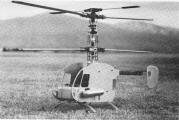Kalt Kamov (1982)
Kalt, as part of their R&D program, experimented with the Contra-rotating layout of the Russian Kamov helicopters. This type of model had been made by home builders a number of times and so was not, as such, a 'new' thing. However, though they had proved reasonable stable in hovering and slow flight, fast forward or aerobatics had not yet been achieved.
The layout consisted of a lower rotor with collective pitch but NO cyclic controls and the upper head looks like a full K-1 SB. Upper swashplate is driven by four linkages connected to a lower swashplate with the raising or lowering of this assembly transferring pitch control to the upper rotor blades; lower blade collective is by sliding rod through the main shaft to a collar connected to the lower main blade holders.
There appears to have been a little bit of confusion about how this worked and this was brought about because visibly it only has cyclic and collective control and unlike others contra-rotating helicopters of the time did not have movable 'vanes' to act as a 'rudder'. As such it was thought to fly on three channels in a similar manner to the Breguet of UK's Roy Sturman from 1980 and covered in this article - Roy Sturman. However, indications are that it was fully functional and if so then rotation about the vertical axis would be achieved by altering the pitch of each rotor in opposition; as opposed to height control which was achieved by alter the pitch of each rotor 'collectively'. Why in opposition, well a normal helicopter requires a tail rotor to counter the torque produced by the main rotor which tries to turn the helicopters body in the opposite direction to that of the main rotors rotation. In a contra-rotating machine, the torque of one rotor is countered by the other rotating in the opposite direct so when at the same pitch the torque is equal and the helicopter stays pointing in the same direction. If the pitch of one is increased thus increasing the torque reaction whilst the pitch of the other is decreased thus reducing its torque reaction, an imbalance occurs and the body rotates in the direction of the rotor blades with the lower pitch setting; thus rotation either way can be achieved.
Control is thus achieved by the following:
| Left or right bank |
Left or right cyclic on upper rotor. |
| Forward or backward flight | Forward or backward cyclic on upper rotor |
| Height |
Increase or decrease pitch on both rotors |
| Right rotation |
Increase pitch lower rotor, decrease pitch upper rotor |
| Left rotation | Decrease pitch lower rotor, increase pitch upper rotor |
It therefore required the 'normal' four channels to fly, two for cyclic and two for rotor pitch with a mixer arrangement to give collective or opposition control of the main rotors.
The above is though not confirmed and whilst this type of control achieved by mechanical means would have been quite complicated, as the later Hirobo Vertol was to prove, not beyond the abilities of experienced pilots to build and set up. Unfortunately it would appear that this model was not developed any further than this prototype and looking back I suspect it was because of its flight characteristics as alluded to in the opening statement. Even in 2010 there were very few large scale contra-rotating helicopters and none that were fully aerobatic or 3D capable. The configuration has too much interaction between the rotors such that once outside of the safe 'limited' performance envelope, instability occurs generally followed by a crash. Whilst this kind of behaviour by 2010 could be sorted to a reasonable at least for 'scale' flying given the Flybarless gyro technology coming to the fore, back in 1982 gyro's were in their infancy and at best only provided a 'rate' action. Whilst this could tame rapid movement it could not prevent the kind of instability experienced when a contra-rotating machine was pushed too far and by the time technology had provided better gyro's, Kalt were more interested in high end pod and boom helicopter's so this idea was not to be resurrected.

